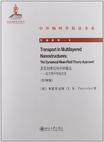多层纳米结构中的输运
出版时间:2012-12 出版社:北京大学出版社 作者:弗雷里克斯 页数:327
内容概要
为有力推动我国物理学研究、加快相关学科的建设与发展,特别是展现近年来中国物理学者的研究水平和成果,北京大学出版社在国家出版基金的支持下推出了《中外物理学精品书系》,试图对以上难题进行大胆的尝试和探索。《中外物理学精品书系·引进系列(3)·多层纳米结构中的输运:动力学平均场方法(影印版)》编委会集结了数十位来自内地和香港顶尖高校及科研院所的知名专家学者。他们都是目前该领域十分活跃的专家,确保了整套丛书的权威性和前瞻性。 《中外物理学精品书系·引进系列(3)·多层纳米结构中的输运:动力学平均场方法(影印版)》内容丰富,涵盖面广,可读性强,其中既有对我国传统物理学发展的梳理和总结,也有对正在蓬勃发展的物理学前沿的全面展示;既引进和介绍了世界物理学研究的发展动态,也面向国际主流领域传播中国物理的优秀专著。可以说,《中外物理学精品书系》力图完整呈现近现代世界和中国物理科学发展的全貌,是一部目前国内为数不多的兼具学术价值和阅读乐趣的经典物理丛书。 《中外物理学精品书系》另一个突出特点是,在把西方物理的精华要义“请进来”的同时,也将我国近现代物理的优秀成果“送出去”。物理学科在世界范围内的重要性不言而喻,引进和翻译世界物理的经典著作和前沿动态,可以满足当前国内物理教学和科研工作的迫切需求。另一方面,改革开放几十年来,我国的物理学研究取得了长足发展,一大批具有较高学术价值的著作相继问世。这套丛书首次将一些中国物理学者的优秀论著以英文版的形式直接推向国际相关研究的主流领域,使世界对中国物理学的过去和现状有更多的深人了解,不仅充分展示出中国物理学研究和积累的“硬实力”,也向世界主动传播我国科技文化领域不断创新的“软实力”,对全面提升中国科学、教育和文化领域的国际形象起到重要的促进作用。
作者简介
作者:(美国)弗雷里克斯(Freericks J.K.)
书籍目录
Preface Acknowledgments 1. Introduction to Multilayered Nanostructures 1.1 Thin Film Growth and Multilayered Nanostructures 1.2 Strongly Correlated Materials 1.3 The Proximity Effect 1.4 Electronic Charge Reconstruction at an Interface 1.5 Roadmap to Real-Materials Calculations 2. Dynamical Mean-Field Theory in the Bulk 2.1 Models of Strongly Correlated Electrons 2.2 Second Quantization 2.3 Imaginary Time Green's Functions 2.4 Real Time Green's Functions 2.5 The Limit d →∞ and the Mapping onto a Time-Dependent Impurity Problem 2.6 Impurity Problem Solvers 2.7 Computational Algorithms 2.8 Linear-Response dc-Transport in the Bulk 2.9 Metal-Insulator Transitions within DMFT 2.10 Bulk Charge and Thermal Transport 3. Dynamical Mean-Field Theory of a Multilayered Nanostructure 3.1 Potthoff-Nolting Approach to Multilayered Nanostructures 3.2 Quantum Zipper Algorithm (Renormalized Perturbation Expansion) 3.3 Computational Methods 3.4 Density of States for a Nanostructure 3.5 Longitudinal Charge Transport Through a Nanostructure 3.6 Charge Reconstruction (Schottky Barriers) 3.7 Longitudinal Heat Transport Through a Nanostructure 3.8 Superconducting Leads and Josephson Junctions 3.9 Finite Dimensions and Vertex Corrections 4. Thouless Energy and Normal-State Transport 4.1 Heuristic Derivation of the Generalized Thouless Energy 4.2 Thouless Energy in Metals 4.3 Thouless Energy in Insulators 4.4 Crossover from Tunneling to Incoherent Transport in Devices 5. Josephson Junctions and Superconducting Transport 5.1 Introduction to Superconducting Electronics Devices 5.2 Superconducting Proximity Effect 5.3 Josephson Current 5.4 Figure-of-Merit for a Josephson Junction 5.5 Effects of Temperature 5.6 Density of States and Andreev Bound States 6. Thermal Transport 6.1 Electronic Charge Reconstruction Near a Metal-Insulator Transition 6.2 Thermal Transport Through a Barrier Near the Metal-Insulator Transition 7. Future Directions 7.1 Spintronics Devices 7.2 Multiband Models for Real Materials 7.3 Nonequilibrium Properties 7.4 Summary Appendix A Problems A.1 Jellium model A.2 Density of states for the hypercubic lattice in 1, 2, 3,and ∞ dimensions A.3 Noninteracting electron in a time-dependent potential A.4 Relation between imaginary-time summations and real-axis integrals A.5 The Green's functions of a local Fermi liquid A.6 Rigid-band approximation to the Falicov-Kimball model A.7 Comparing the spectral formula to the Hilbert transform A.8 Imaginary-time Green's functions A.9 Partition function for a spinless electron in a general time-dependent field A.10 Mapping the impurity in a field to an impurity coupled to a chain in the NRG approach A.11 Impurity Green's function for the chain Hamiltonian in the NRG approach A.12 Solving the NRG many-body Hamiltonian for the chain A.13 Metal-insulator transition in the half-filled Falicov-Kimball model A.14 Kramers-Kronig analysis for the Green's function, and the effect of the pole in the Mott insulator A.15 Metal-insulator transition on a simple cubic lattice A.16 DC conductivity for the simple cubic lattice A.17 Jonson-Mahan theorem A.18 Charge and thermal conductivity for the Falicov- Kimball model A.19 The particle-hole asymmetric metal-insulator transition A.20 Non Fermi-liquid behavior of the Falicov-Kimball model A.21 Thermopower of the Falicov-Kimball model and the figure-of-merit A.22 U →∞ Green's functions A.23 Determining Gαβ from the quantum zipper algorithm A.24 The stability of the left and right recursion relations of the quantum zipper algorithm A.25 Efficient numerical evaluation of integrals via changes of variables A.26 Equilibrium solutions with charge reconstruction A.27 Local charge and heat current operators for a nanostructure A.28 Operator identity for the Jonson-Mahan theorem A.29 BCS gap equation A.30 Equations of motion needed for the Nambu-Gor'kov formalism A.31 Spin one-half atom in a time-dependent normal and anomalous dynamical mean field A.32 Hilbert transformation in the Nambu-Gor'kov formalism A.33 Evaluating Hilbert transformation-like integrals needed for determining the bulk critical current on a simple-cubic lattice A.34 The single-plane Mott-insulating barrier A.35 Green's functions of the particle-hole symmetric Falicov-Kimball model nanostructure A.36 Parallel implementation for the resistance calculation of a nanostructure A.37 Resistance and Thouless energy of a nanostructure Bibliography Index
章节摘录
版权页: 插图: superconducting pair of electrons is incident from the left. This pair of electrons meets a hole in the normal-metal barrier, leaving an electron behindthat moves to the right. That electron travels to the barrier-superconductorinterface on the right, and a superconducting pair and a retroreflected holeemerge; the hole travels to the left in the metal, and the superconductingpair travels to the right in the right superconducting lead. The net effectis that a superconducting pair has been carried across the barrier from theleft to the right, and there is a localized electron-hole state that remainsin the barrier. A similar process can carry current in the opposite direction, and one can view the lack of supercurrent when there is no phasedifference across the junction as corresponding to an equal occupation ofthe left and right current-carrying states. In a one-dimensional system, theAndreev bound state has a well-defined energy, but in a three-dimensionalsystem, because of the possible nonzero value for the transverse (kx andkv) momenta, these Andreev bound states appear as finite-width peaks inthe DOS. Because the electrons involved in the Andreev bound states have energies close to the chemical potential, we expect these states to be locatedat an energy below the bulk superconducting gap. When scattering is added to the barrier, we can characterize the level ofscattering with the Thouless energy for the diffusive metal barrier (plus thecontribution from the contact resistance, of course). When such scatteringis included, quasiclassical calculations say there will be a so-called "hard"minigap in the DOS, where the DOS vanishes over a region proportionalto ETa about the chemical potential [Golubov and Kupriyanov (1989);Golubov, Wilhelm and Zaikin (1997); Zhou, et al. (1998); Pilgram, Belzig,and Bruder (2000)]. Since there is no gap when there is no scattering,and the Thouless energy decreases as the thickness of the barrier increases,the gap region is expected to first grow, and then decrease as scattering isturned on. Since a ballistic-metal-barrier junction has a nonzero Thoulessenergy, this analysis cannot be consistent with the Thouless energy solely determining the minigap, but most quasiclassical approaches ignore thecontact resistance contribution to the Thouless energy, so from their perspective, the Thouless energy vanishes for a ballistic-metal-barrier junction,and the analysis is consistent.
编辑推荐
《多层纳米结构中的输运:动力学平均场方法(影印版)》可以作为相关领域研究生的教材,也可作为科研工作者的参考书。
图书封面
评论、评分、阅读与下载
